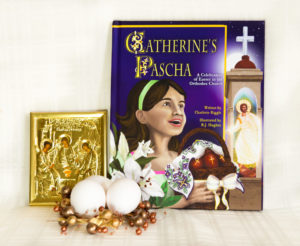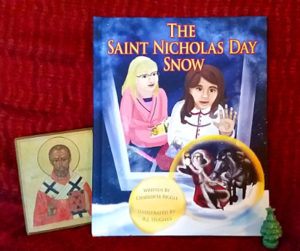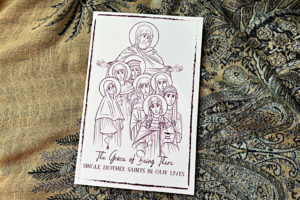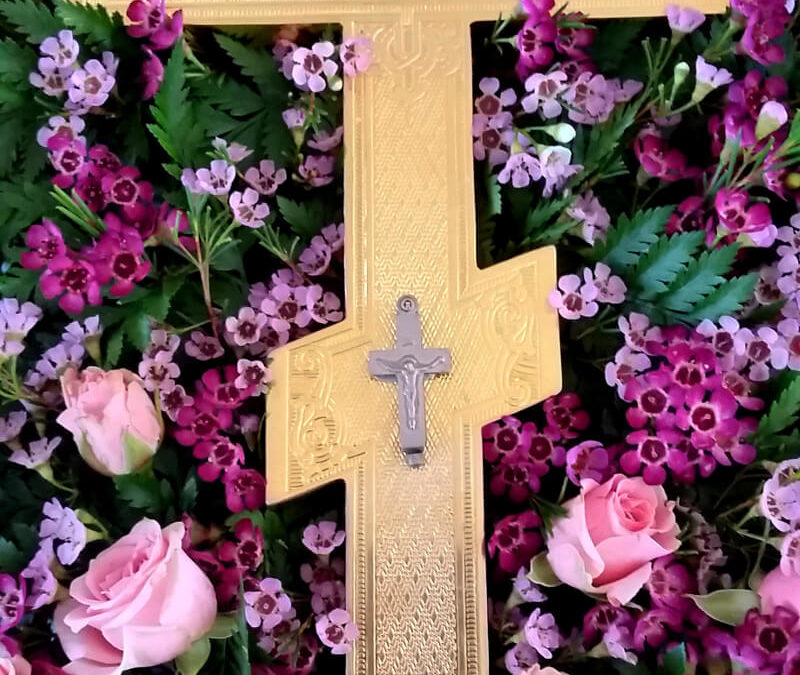First published May 21, 2016
In the Orthodox Church, we celebrate the holy and life-giving Cross with a Great Feast in mid-September, and again on the third Sunday of Lent.
The Finding of the True Cross
The Great Feast commemorates the finding of the True Cross: After the Council of Nicea, Constantine’s mother, St. Helena, went on a pilgrimage to Jerusalem. There, during excavations made at her behest, three crosses were uncovered.
Believing that these were the crosses mentioned in the Gospel, she asked the bishop, Macarius, to help determine which one had been the cross on which Jesus had died. Macarius had a woman near death brought out, and touched with the wood of each of the crosses in turn. Nothing happened when she was touched with the wood of the first cross or the second, but at the touch of the third cross, the woman recovered.
St. Helena declared that this third cross was the True Cross, the Cross on which Jesus had been crucified.
Thus, the Great Feast commemorates the finding of the True Cross and the consecration of the Church of the Holy Sepulchre. It’s about things you can touch and taste and smell. It’s about sickness and health. It’s about stones and wood and basil.
The Cross at Mid-Lent
The veneration of the Cross in mid-Lent is different. It’s about the meaning of the cross, about how we respond to it. Instead of being placed on a bed of basil, the Cross is carried on a bed of daffodils or other early spring flowers, to make us think of life and joy.
In the words of the Synaxarion:
On this the Third Sunday of Great Lent, we observe the Veneration of the Precious and Life-giving Cross and for this reason: Inasmuch as in the forty days of fasting we in a way crucify ourselves and become bitter, despondent and failing, the Life-giving Cross is presented to us for spiritual refreshment and assurance, for remembrance of our Lord’s Passion and for comfort. Like those who are following a long and tedious path are tired, see a beautiful tree with many leaves, they would sit in its shade and rest for a while and then, as if rejuvenated, they will continue their journey. Likewise today, in the time of fasting and difficult journey and effort, the Life-giving Cross was planted in its
midst by the Holy Fathers of the Church to give rest and spiritual refreshment, to make us light and courageous for the remaining task.
The Dispersal of the Cross
So what happened to the True Cross, after St. Helena found it? When she returned to Constantinople, St. Helena took part of the Cross with her. She left most of it in Jerusalem, in the care of the bishop, who had it encased in silver and kept at the Church of the Holy Sepulchre.
Over time, though, tiny slivers of the Cross were broken off of the larger pieces, encased in gold reliquaries, and worn as jewelry. Larger pieces were taken for churches and monasteries. By 348, St. Cyril of Jerusalem said that these bits of the Cross filled the entire world. He was speaking metaphorically, of course, but more than a thousand years later, John Calvin said that if you gathered up all the bits of the True Cross, you’d have enough wood to fill a large ship.
Some people think that was just Calvin’s anti-Catholicism showing, and if you gathered up all the bits of wood that are thought to be relics of the True Cross, there wouldn’t be an excess of wood. The Cross was large; the splinters in reliquaries around the world are small.
Relics True and Otherwise
There is, of course, no way of knowing whether any particular splinter came from the True Cross. During the Middle Ages, every church needed relics for its altar, and every pious and faithful person wanted relics of a saint. A great market in relics grew up. True relics were given, stolen, bought, and sold. Particularly important relics – like the Cross – were broken up so that more people and more parishes could have a bit.
From time to time, it’s clear that mistakes happened. A young man who inherited his grandfather’s reliquary might remember that it contained a finger bone from St. John the Evangelist, when it was in fact the finger bone of some other St. John.
And not all of the mis-identified relics were honest mistakes. As there have been frauds and sinners from the beginning until now, fake relics were passed off as real.
The more important the relic, the more often mistakes happened, and the more often fraud happened. And what relic was more important than the True Cross?
The Meaning of Relics
If that’s true, if it can’t be proven that all of the relics of the True Cross are in fact bits of the cross on which Christ died, then what is the use of having these relics?
The value of the Cross isn’t in miracles. No one today is going to go find a sick woman to see if the relic in the altar of a parish church will cause her to be restored to health. Even St. Helena didn’t do that, after she once determined which of the unearthed pieces of wood was the True Cross.
The Cross isn’t a talisman. Instead, like all relics, it is an intersection of the world bound by time and space and the world where time and space have no relevance. It is an object that touches both time and the time outside of time. It connects where we are, our place, our time, with the Kingdom of Heaven.
In icons, this collision of worlds is shown by a mandorla, a set of concentric rings of white light that surrounds Jesus in icons of the Transfiguration and the Annunciation and the Anastasis.
Because God chose to break the barrier between Creator and Creation by taking on material flesh, the connections between this world and the Eternal World are mostly material. It’s not that God can’t approach us through a voice or a vision. He can, and sometimes he does. But more often, because of the Incarnation, he approaches us through matter.
Bits of bone or flesh. Dust from a grave. Oil weeping from an icon. A bit of wood from the True Cross.
Icons of Eternity
A parish I used to attend has a relic from the True Cross. When it is placed on the icon stand in the middle of the church, and I approach it, I am overcome with awe.
Here, in a tiny fragment of wood in a tiny reliquary, death and Life meet. Here, a splinter of wood becomes a singularity, encompassing all that has been, and all that is, and all that will be.
And that is true whether, historically speaking, this particular bit of wood was ever physically part of the True Cross. Because if this bit of wood is not a relic, it is an icon, an image of that which is true. Whether a relic or an icon, this bit of wood transcends time and space, and connects us, our place, our time, with the Kingdom of Heaven.
Read More
The Exaltation of the Cross and a bed of basil: On the second Great Feast of the liturgical year, the Cross is placed on a bed of basil and carried in a solemn procession in the church. Not daffodils. Not roses. Basil Why basil?
St. Helena and the Cats of Cyprus: On her way home from Jerusalem, St. Helena stopped by Cyprus to leave a fragment of the True Cross with a monastery there. She found the island suffering from drought, hunger, and snakes. Determined to help, she sent the monastery a thousand cats.
Justinian and Theodora: A Love Story: St. Theodora, the wife and co-ruler with St. Justinian the Great, is one of my very favorite saints.
Books by Charlotte Riggle

This holiday classic shares the joy of Pascha through the eyes of a child. Find it on Amazon or Bookshop.org.
![]()

This delightful story is filled with friendship, prayer, sibling squabbles, a godparent’s story of St. Nicholas, and snow. Lots and lots of snow. Find it on Amazon or Bookshop.org.
![]()

In this collection of essays, women who are, or have been, single mothers share stories of their relationships with saints who were also single mothers. Charlotte’s story of the widow of Zarephath highlights the virtue of philoxenia. Find it on Amazon or Park End Books.




